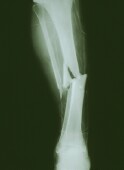But stronger bones did not translate into fewer fractures in this elderly, high-risk population
MONDAY, April 13, 2015 (HealthDay News) — Frail, older women may only need a single dose of the osteoporosis drug zoledronic acid (Reclast) to build bone strength, a new study suggests. But greater bone density did not translate into fewer fractures among these high-risk women, who were living in nursing homes and assisted-living facilities during the study. The research was published online April 13 in JAMA Internal Medicine.
Susan Greenspan, M.D., a professor of medicine at the University of Pittsburgh, and colleagues assigned 181 women with osteoporosis, aged 65 and older, to a single infusion of zoledronic acid or a placebo. All of the women were also given vitamin D and calcium supplements. Some of these seniors also suffered from mental impairment, immobility, and other medical conditions, the researchers noted. After a year and again after two years, the researchers measured the women’s bone density at their hip and spine. They also tracked any falls or other adverse events.
After a year, women given zoledronic acid saw bone density at the hip increase an average of 2.8 percent, compared with a slight reduction in bone density among women given a placebo. At two years, bone density increased 2.6 percent among women given the drug, but decreased 1.5 percent among those given placebo, the researchers found. The average bone density at the spine also increased among women treated with zoledronic acid more than women given the placebo. At 12 months, bone density increased 3 percent among zoledronic acid users, versus 1.1 percent in the placebo group. At 24 months, the increases were 4.5 and 0.7 percent, respectively.
But Greenspan’s group found no significant difference in the number of fractures, cardiac disorders, or deaths among women who received the drug or the placebo. Among women treated with zoledronic acid, 20 percent had fractures, as did 16 percent of those treated with placebo. Among those given the drug, 16 percent died, as did 13 percent of those given placebo. More women treated with the drug had multiple falls than did women given the placebo (49 versus 35 percent), although this difference was not significant after taking into account frailty at the start of the study, the researchers said. The number of single falls was similar among women in both groups, they added.
Copyright © 2015 HealthDay. All rights reserved.








